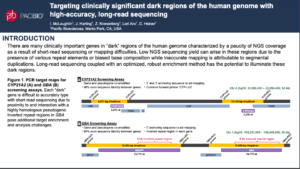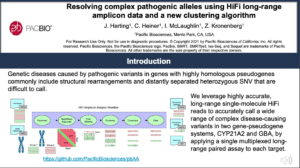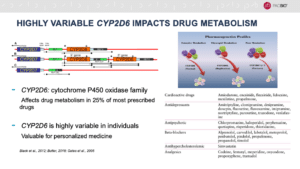It’s a challenge that has haunted rare disease researchers for years: how to increase solve rates in rare and Mendelian disease. Currently, the genetic cause of more than half of rare disease cases worldwide remain unexplained.
In a series of talks and posters presented at the 2021 annual meeting of The European Society of Human Genetics (#ESHG21), PacBio experts and users described how HiFi sequencing could help close the gap by providing more comprehensive, accurate and high-definition coverage of the gaps in the human genome.
Here is a summary of the discussions that took place and the posters that were presented:
In the first workshop, Susan Hiatt (@suzieqhiatt) from HudsonAlpha Institute for Biotechnology discussed how she and her team used HiFi sequencing in their rare disease research to discover genomic variation missed by whole-exome or genome sequencing studies using short reads.
PacBio’s Chief Scientific Officer Jonas Korlach also provided a summary about how advancements in sequencing technology, coupled with improved analytical tools and databases, have made it possible to finally examine hard-to-reach regions of the human genome, with huge implications for rare disease research.
“PacBio continues this march of technology evolution, and soon more than half, and perhaps up to two-thirds of unexplained rare disease cases can be explained through HiFi sequencing,” – Jonas Korlach
He went on to say: “We believe that high quality whole genome sequencing is the future of medicine and that this will be the first of many impactful demonstrations.”
Learn more about the work here.

In a poster presentation, researchers at PacBio showed how there are many clinically important genes in “dark” regions of the human genome. They explained how these often exist because of a paucity of NGS coverage or mapping difficulties, often complicated by the presence of various repeat elements or segmental duplications.
View the poster to see how long-read sequencing coupled with a long-PCR targeted enrichment method has the potential to illuminate these dark regions, using examples from CYP21A2, responsible for congenital adrenal hyperplasia, and GBA, responsible for Gaucher’s disease.

In another poster presentation, experts outlined how many genetic diseases are mapped to structurally complex regions containing highly similar paralogous alleles (>99% identity) that span kilobases and how, as a result, comprehensive screening for pathogenic variants is incomplete and labor intensive using short-reads or optical mapping.
View this poster to find out how long-range amplification and PacBio HiFi sequencing can fully resolve and phase a wide range of pathogenic variants with the help of a new amplicon analysis tool, pbAA.
Full-Length Sequencing of CYP2D6 Locus with HiFi Reads Increasing Genotypes Accuracy

And, in the final poster presentation, there was an insightful deep dive into personalized medicine. This poster reviews new discoveries around how the highly polymorphic CYP2D6 gene impacts the metabolism of 25% of the most prescribed drugs on the market. Experts reviewed this poster to inspire a discussion around how accurate identification of variant CYP2D6 alleles in individuals is necessary for personalized medicine.
View the poster to see how HiFi sequencing coupled with long-PCR targeted enrichment has successfully characterized 22 samples from a pharmacogenomics reference panel.
Comprehensive Detection of Variants in Unsolved Rare Disease Studies with PacBio HiFi Reads
Lastly, experts discussed how PacBio HiFi reads (99.9% accuracy, 15-25 kb) enable comprehensive variant detection in human genomes, extending to repetitive regions of the genome not accessible with short-read WGS (srWGS). It was revealed that HiFi reads match or surpass srWGS for single nucleotide variant and small indel detection while also improving detection of structural variants (SVs), with recall far exceeding that of srWGS.
This talk showcased how HiFi can be applied in a large-scale, reproducible way using an automated workflow, and how it performed on 80 rare disease cases unexplained by srWGS.
All in all, ESHG 2021 was full of insight, discovery and hope. With HiFi sequencing, we are excited about what the future holds.
If you would like to watch the workshop recording on demand, go here.
Or, if you’d like to learn more about highly accurate long-read sequencing and how it plays a role in human biomedical research, visit us here.